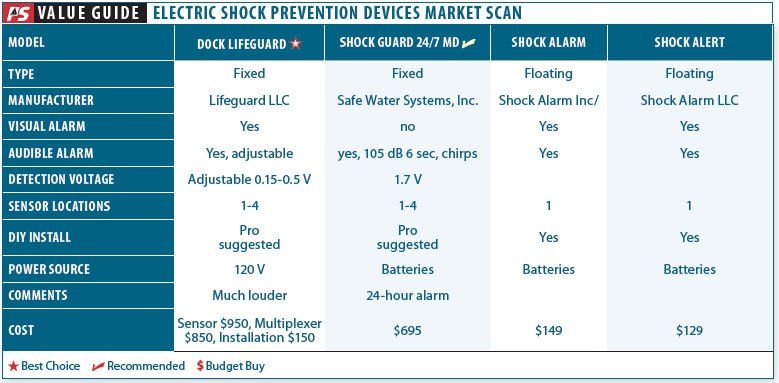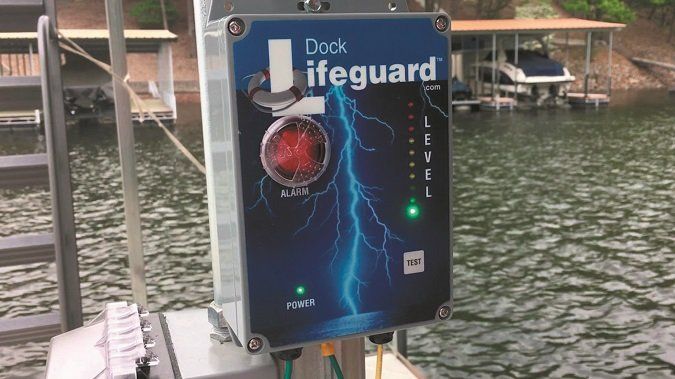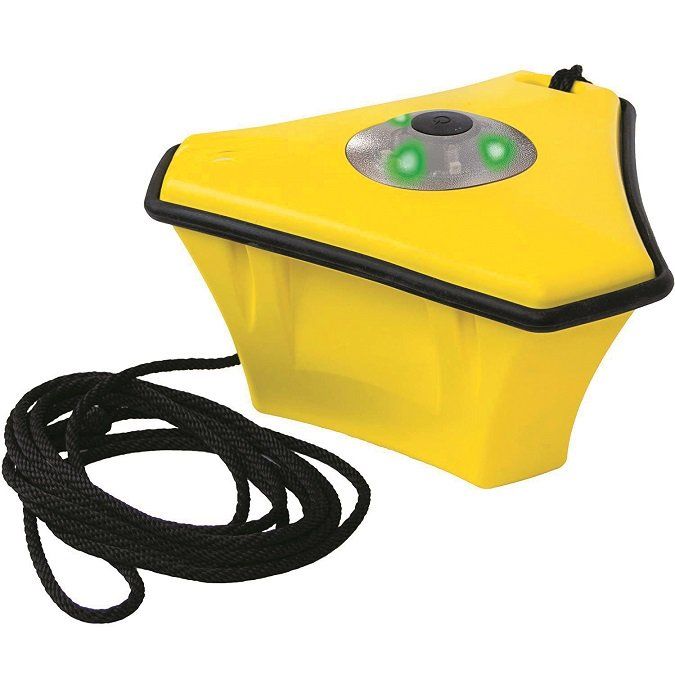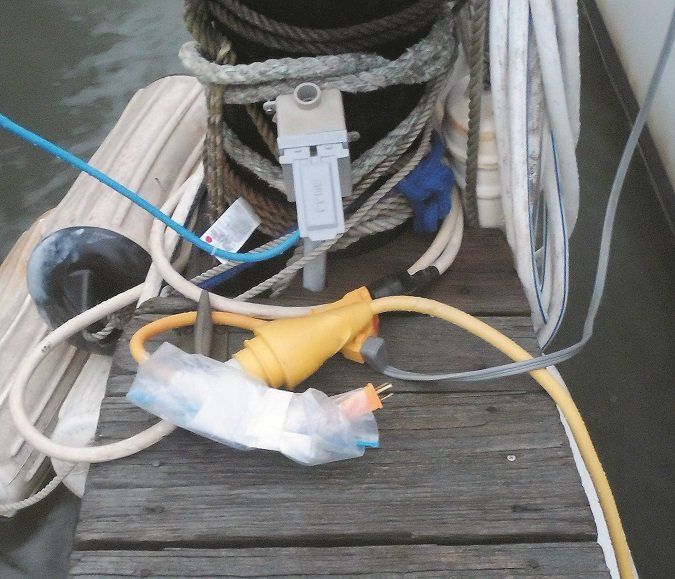The human body runs on electricity and if you overload the nervous system with an external field, everything goes haywire. Every year several people die because they go swimming near a dock, a wiring fault creates an electric field in the water, and their muscles freeze. It is called Electric Shock Drowning (ESD).
A victim of ESD doesn’t always appear to struggle, because they physically can’t. Their diaphragm is paralyzed, their swimming muscles incapacitated, and they simply sink. This danger is regarded as almost exclusively limited to freshwater-although no one should ever consider a saltwater marina to be free of electrocution risk. The human body is more conductive than freshwater, but less conductive than salt water. Because current seeks the least resistant path, the preferred electrical path in freshwater is your body, while in saltwater-except in unusual circumstances (metal prosthetics, for example)-it is water.
How to Avoid ESD
Never swim near docks with AC power. Encourage your marina to test periodically for leakage.
- When you go for a sail, switch off the AC power breakers onboard and at the shore power pedestal and unplug the power cord.
- Move your boat at least 150 yards from any marina before entering the water to perform maintenance or to scrub the bottom. In freshwater, the power gradient can extend as much as 150 feet from the fault.
- If the dock is used by swimmers, install only low voltage lighting and no power outlets.
- Never use 120 volt power tools from a tender or float, or even in a way where wet conditions can create a ground through you. Using power tools near freshwater or saltwater can be lethal. The seawater becomes an excellent coupler from the sailor to ground, and wet hands make a good connection to the power tool.
- Always use GFI protection. If theres none in the circuit, install a GFI pigtail.
- If you must swim in a saltwater marina, unplug yours and nearby boats and turn off pedestal breakers and battery switches. This should eliminate the
remote risk of a severe fault. - Although swimming pool electrocutions are extremely rare (all pools equipment must meet strict safety codes),
accidents can happen. Never swim if a portable 120-volt pump is in use. - Never swim in or near freshwater marinas.
Do not swim around freshwater docks that have electrical equipment. - Install galvanic isolator in all shore power systems. This provides a barrier between the shore ground and hull ground.
- Install a solar system on your boat, eliminating the need for shore power.
Field Detectors
While the best policy is to stay out of the water, a lakeside dock is a kid magnet. There are electric field detectors, that with various levels of rigor, detect dangerous faults.
These units simply measure the difference in voltage between the shore power ground and the water where the sensor is located. If it is located too far from the fault or located close to a grounded, metal portion of the dock, it may not measure a voltage differential. There is no UL listing for this category of products. Although several units claim to be UL certified, this appears to be in reference to their UL-compliant components. There is no universal standard for this type of equipment.
What We Tested
Ordinarily Practical Sailor tests all of the equipment we review, but for this preliminary market scan, we interviewed the manufacturers and several users, and reviewed the specifications.

Fixed Mount Alarms
For fixed units, professional installation is strongly recommended, both to ensure that the unit is properly installed and to inspect all wiring for compliance with current electrical code (compliance with original code at time of construction means nothing). Installation cost varies, typically from $150 to $350.
Dock Lifeguard A single sensor, properly placed, is said to protect an area about 40 feet on a side. Up to four sensors may be used to increase the area of coverage. The panel includes both LED indicating the relative strength of the field, and loud alarm, and a flashing light, from $950 (www.docklifeguard.org/index.html).
Safe Water Systems Shock Guard 24/7 Up to four sensors, each protecting a 26-foot radius. Detects as little as 1.7 volts differential from ground. Powered by a 9 volt battery, the alarm, which is not very loud, emits six second chirps for 24 hours, after which the battery is dead. Annual replacement is required. The battery can be tested by placing a supplied magnet against the panel is a specific location, which lights a light and causes a chirp. Panel includes 105 dB buzzer and contacts to trip up to four GFI circuits, $695 (www.safewatersystemsinc.com).

Portable Floating
Targeted at the swimming pool market, these float on the surface and measure the electrical gradient between closely spaced sensors. As a result, range is limited. They are best used by walking them around the edge of a pool before use. As such, they may not detect changes after the swimmers enter the water. Additionally, they provide very little or no protection against hot electrical equipment near the water, such as lifts, railings, and dock frames.
Shock Alert This free-floating sensor detects tiny potential differences across its 5-inch width. A green flashing light is displayed if no gradient is detected, and a beeper and flashing red light activate if a gradient is present. $150 online and through Home Depot.
(www.shockalert.com).
Shock Alarm Another free-floating sensor, the Shock Alarm measures the gradient in a small area, and flashes and beeps if any current is detected. $129.00 online (www.shockalarm.com).

Conclusions
We do not recommend the floating units. While they may provide some protection, failure to detect hot boat lifts and limited range allows too much room for error. We stand by the conclusions of the Electric Shock Drowning Organization, which does not support the use of what they refer to as green light devices. According to the ESO, these devices can encourage swimming in potentially hazardous areas, placing more people at risk. And, of course, the devices can fail.
Additionally, fault could occur after people have entered the water, with a new circuit introduced or activated. Given the prevalence of failures of boat electrical equipment and in marinas, the potential for failure is a valid point.
It is also important to remember that electricity is not the only hazard for swimmers in marinas. Moving boats, turning propellers, and entanglement hazards are just a few of the risks.
Does the equipment work? The most adamant insist that you can never be safe enough, since current detectors have their limitations. On the other hand, if you strictly adhere to these safety tips around the water and only use such devices as a means of fault or failure detection, we see value here.


































With all due respect, everything I read shows salt water to be a good conductor. How else does the bodies electrical system work, and in a normal saline, low concentration, of sodium?
Ernest M Kraus
graduate pharmacist
Salt water certainly is a good conductor, and, yes, your internal body fluids require a certain level of varied electrolytes to function properly, but re-read the statement from above:
“The human body is more conductive than freshwater, but less conductive than salt water.” It’s a matter of degree.
Simply put …. L1 or l2 shore power wants to seek mother earth . On a boat , let’s say there is a slight short from one of these hot Leeds to a thru hull. Electrons always , always seek the path of the least resistance ( as well as the shortest path ) to the earth. Salt water is a better conductor of these electrons than fresh . Therefore, they will travel easily through salt water as opposed to fresh. Again , most of the harmful potential in this case will travel to its muddy destination through the salty water and less through a swimmer. Nevertheless , follow the above precautions in this article . There have been times when a diver scrubbing a bottom in salt water has complained of a tingling sensation . This is due to a slight A/C leak to a through hull. The tingling sensation might have been more severe in fresh water
Sorry to say this but electricity does not want to go to ground I is seeking the path of leace resistance back to the source it was created. If that means using ground the it will follow it however it is not the preferred route
It’s a bit misleading to state the axiom that electrons seek the path of least resistance. If 3 resistors are connected in parallel (call them low, medium, and high R) and connected to a voltage voltage source, current will flow in all 3; the current being the least in the high R. The high R being the swimmer in salt water.
Saying that current takes the shortest path is inaccurate. Think of a 20′ copper wire in parallel with a tiny resistor. Perhaps with lightning, the shortest path is most likely as the air becomes ionized but is otherwise homogeneous.
Get Instant Support If Hp Printer Keep Going Offline in Windows 10. Our Expert will help Getting Hp Printer Offline to Online | PRINTER CHAT SUPPORT 24×7.
There is a new tool recently available called Canary known as an EWACT ( electrified water and current tester )
This new device can be used to sweep the marina and in and around boats to locate where electricity is straying from. One of its functions is to point to the exact location of the source enabling the operator to walk directly up the boat or faulty cable with ease and speed once power is detected. Fully patented and UL / CSA approved designed with first res ponders, marina operators and trades people in mind. It can be found at
http://www.ewact.com
Regarding the statement pertaining to Dock Life Guard having a “loud alarm “ I have to strongly disagree. My just purchased unit was sent back today after the power supply failed. I was very surprised to find no fuse protection on the power supply secondary.
Still waiting to hear something after several emails. I’m a strong supporter of electrical safety everywhere but the jury is still out on this device until I hear back, hopefully to report something positive.
Scott Pargin
Lake Travis
13 maravillosas maneras de ayudarte a lucir el color ultravioleta del ano 2018 de pantone